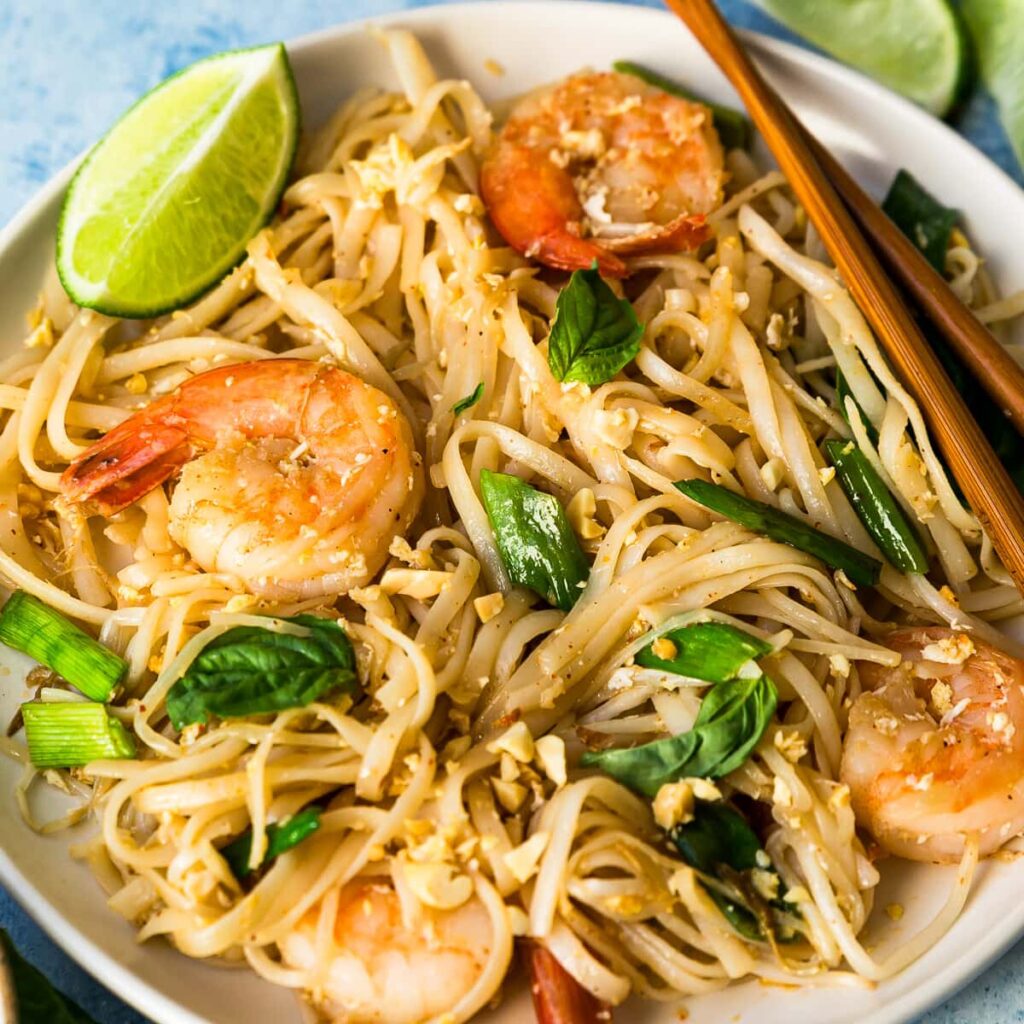
Pad Thai is a iconic Thai street food dish that combines stir-fried rice noodles with a perfect balance of sweet, sour, salty, and spicy flavors. Packed with protein, fresh vegetables, and aromatic herbs, this dish is both delicious and nutritious. In this article, we’ll guide you through making authentic Pad Thai at home, complete with a detailed ingredients list, step-by-step instructions, nutrition facts, and tips to elevate your cooking. Discover the health benefits of this dish and learn how to create a restaurant-quality meal in your own kitchen.
Ingredients List
Here’s what you’ll need to make Pad Thai (serves 4):
- For the Noodles and Protein:
- 8 oz flat rice noodles
- 2 tbsp vegetable oil
- 1/2 lb shrimp, chicken, or tofu (or a combination)
- 2 eggs, lightly beaten
- For the Sauce:
- 3 tbsp fish sauce
- 2 tbsp tamarind paste
- 2 tbsp palm sugar (or brown sugar)
- 1 tbsp soy sauce
- 1 tbsp rice vinegar
- For the Vegetables and Toppings:
- 1 cup bean sprouts
- 1/2 cup chopped green onions
- 1/4 cup crushed peanuts
- 1/4 cup fresh cilantro, chopped
- 1 lime, cut into wedges
- For the Aromatics:
- 3 garlic cloves, minced
- 1 shallot, finely chopped
- 1-2 red chilies, sliced (optional, for heat)
- Optional Add-ons:
- 1/4 cup dried shrimp (for extra umami)
- 1/4 cup pickled radish (for tanginess)

Step-by-Step Recipe
Step 1: Prepare the Noodles
- Soak the rice noodles in warm water for 20-30 minutes until they are pliable but still firm. Drain and set aside.
Step 2: Make the Sauce
- In a small bowl, mix the fish sauce, tamarind paste, palm sugar, soy sauce, and rice vinegar. Stir until the sugar dissolves. Set aside.
Step 3: Cook the Protein
- Heat 1 tbsp vegetable oil in a large wok or skillet over medium-high heat.
- Add the shrimp, chicken, or tofu and cook until fully cooked (shrimp turns pink, chicken is no longer pink, tofu is golden). Remove and set aside.
Step 4: Stir-Fry the Aromatics
- In the same wok, add another 1 tbsp vegetable oil.
- Add the minced garlic, chopped shallot, and sliced chilies (if using). Sauté for 1-2 minutes until fragrant.
Step 5: Cook the Noodles
- Push the aromatics to one side of the wok and add the beaten eggs to the other side. Scramble the eggs until just set.
- Add the drained noodles and the prepared sauce to the wok. Toss everything together to coat the noodles evenly.
- Return the cooked protein to the wok and stir to combine.
Step 6: Add the Vegetables
- Toss in the bean sprouts and chopped green onions. Stir-fry for 1-2 minutes until the vegetables are slightly softened but still crisp.
Step 7: Serve and Garnish
- Transfer the Pad Thai to serving plates.
- Top with crushed peanuts, fresh cilantro, and a wedge of lime.
- Serve immediately with extra lime wedges, chili flakes, or fish sauce on the side.
Nutrition Facts
Here’s the nutritional breakdown for one serving of Pad Thai (based on 4 servings):
- Calories: 450-500 kcal
- Protein: 20g
- Carbohydrates: 60g
- Fats: 15g
- Fiber: 3g
- Vitamins & Minerals: High in Vitamin C, Iron, and Magnesium
Pad Thai is a balanced dish that provides protein, healthy fats, and essential nutrients. The fresh vegetables and herbs add fiber and antioxidants.
Health Benefits of Pad Thai
- Rich in Protein: Shrimp, chicken, or tofu provide essential amino acids for muscle repair and growth.
- Packed with Vegetables: Bean sprouts and green onions add fiber, vitamins, and antioxidants.
- Low in Saturated Fat: Using minimal oil and lean protein makes this dish heart-healthy.
- Boosts Immunity: Garlic, chilies, and lime are rich in Vitamin C and antioxidants that support immunity.
- Customizable: Pad Thai can be tailored to fit dietary needs, such as gluten-free or vegetarian.
Ending Notes and Tips
- Noodle Prep: Don’t overcook the noodles during soaking—they should be firm to avoid becoming mushy when stir-fried.
- Sauce Balance: Adjust the sauce to your taste by adding more fish sauce for saltiness, tamarind for sourness, or sugar for sweetness.
- Meal Prep: Prepare the sauce and chop the vegetables in advance to save time.
- Storage: Store leftovers in an airtight container in the fridge for up to 2 days. Reheat gently in a skillet.
- Presentation: Serve with a side of fresh herbs, lime wedges, and crushed peanuts for a vibrant and authentic look.





